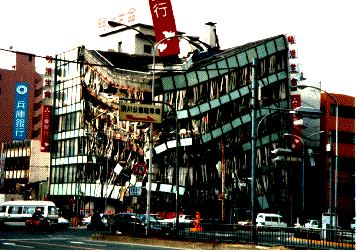MAGNITUDE AND EPICENTER
The Great Hanshin earthquake occurred at 5:46 a.m. on Tuesday, January 17, 1995. This earthquake is also called by the following names: Kobe, South Hyogo, Hyogo-ken Nanbu.
The earthquake had a local magnitude of 7.2. The duration was about 20 seconds. The focus of the earthquake was less than 20 km below Awaji-shima, an island in the Japan Inland Sea. This island is near the city of Kobe, which is a port city.
The earthquake was particularly devastating because it had a shallow focus. The earthquake had a "strike-slip mechanism." The resulting surface rupture had an average horizontal displacement of about 1.5 meters on the Nojima fault. This fault which runs along the northwest shore of Awaji Island.
DEATH TOLL
The earthquake caused 5100 deaths, mainly in Kobe.
The Hanshin earthquake was the worst earthquake in Japan since the 1923 Tokyo earthquake, which is also called the Great Kanto earthquake. The Great Kanto earthquake claimed 140,000 lives.
On the other hand, the Kobe region was thought to be fairly safe in terms of seismic activity.
STRUCTURAL DAMAGE
The cities of Kobe and Osaka are connected by an elevated highway. The earthquake caused several portions of this highway to collapse.
Most of the deaths and injuries occurred when older wood-frame houses with heavy clay tile roofs collapsed. Note that homes and buildings are designed to be very strong in the vertical direction because they must support their own static weight. On the other hand, buildings can be very susceptible to horizontal ground motion.
Furthermore, many of the structures in Kobe built since 1981 had been designed to strict seismic codes. Most of these buildings withstood the earthquake. In particular, newly built ductile-frame high rise buildings were generally undamaged.
Unfortunately, many of the buildings in Kobe had been built before the development of strict seismic codes.
The collapse of buildings was followed by the ignition of over 300 fires within minutes of the earthquake. The fires were caused by ruptured gas lines. Response to the fires was hindered by the failure of the water supply system and the disruption of the traffic system.
PROFESSOR KATAYAMA
Japanese seismology professor Tsuneo Katayama wrote that he "had opportunities to observe the damages caused by the 1989 Loma Prieta and the 1994 Northridge earthquakes." However, he thought that Japanese structures would not collapse as U.S. structures had in those earthquakes.
Professor Katayama also wrote, "While our country was having a bubbling economy, we Japanese forgot to pay due attention to mother nature."
|
